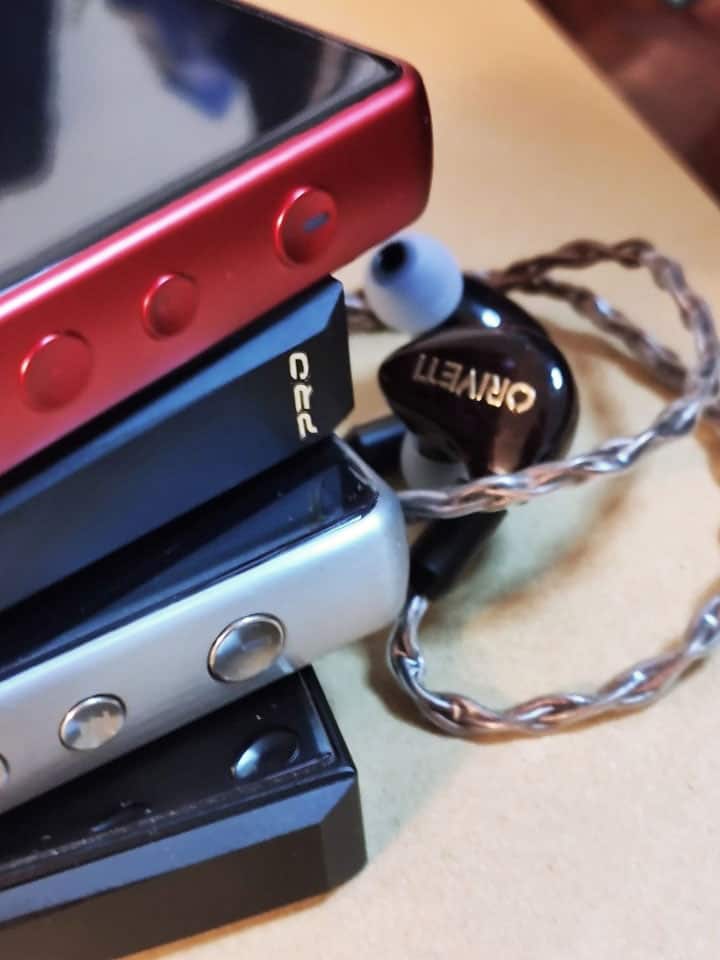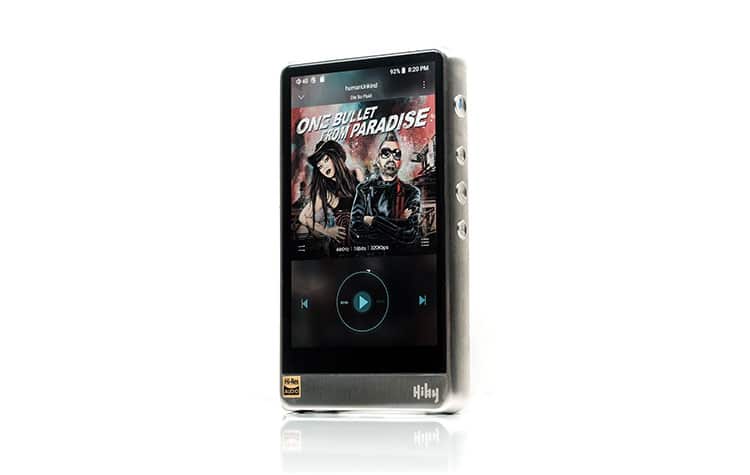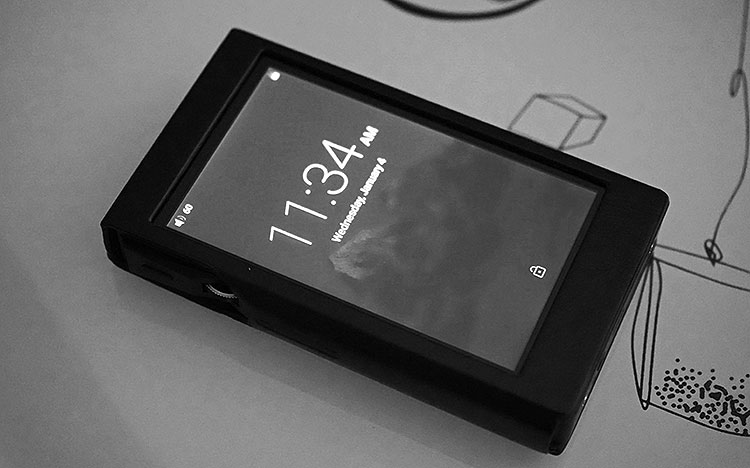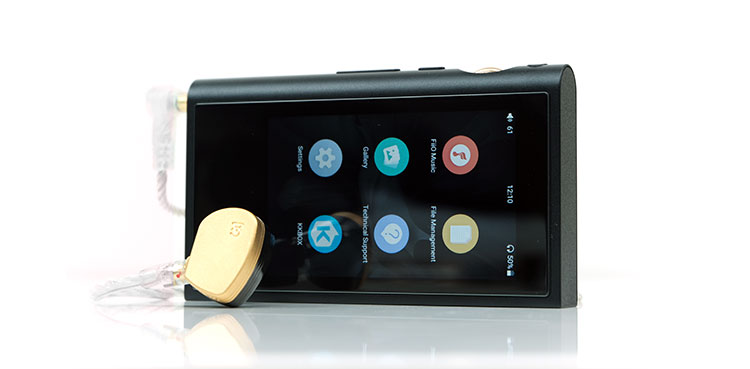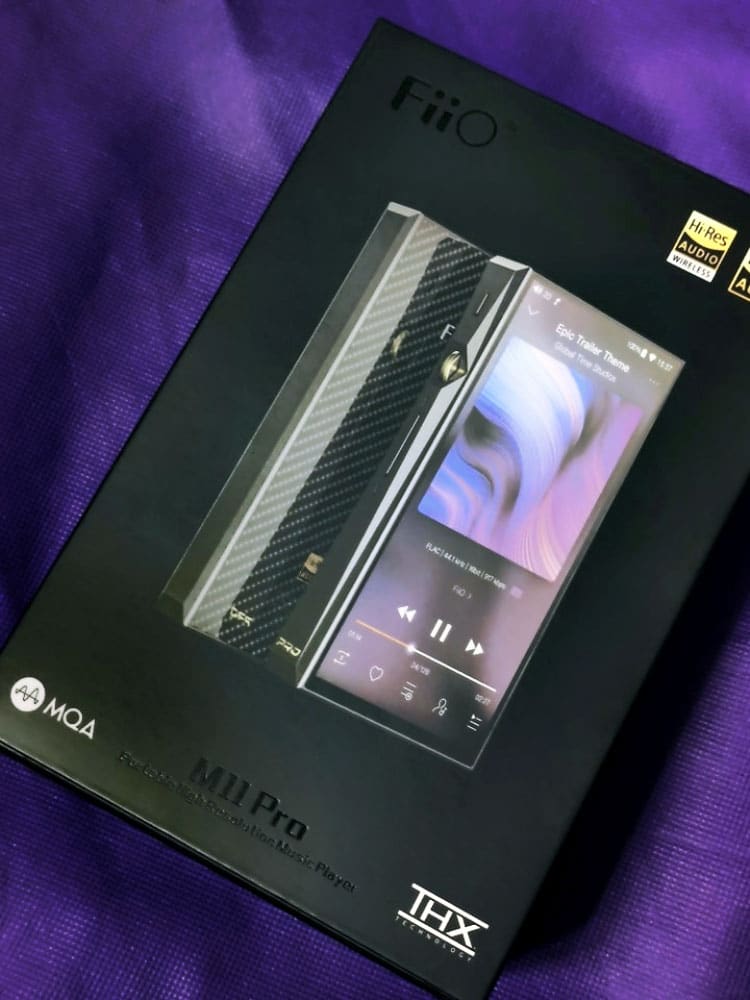Sound Impressions
Setup
The below subjective impressions are made after 10+ days of burn-in, more than 8 hours of playback per day. IEMs including ikko OH1, Oriveti OH300/500, FiiO FA7/FA1, Final B series, and Etymotic’s Er2SE are rotated to test the sound performance.
I am mainly testing under the default Short delay Sharp Roll-Off digital filter under the Pure Music mode to make sure other apps in the background don’t interfere with the decoding power. Impressions are also made with other apps that may have a different default tuning.
Higher resolution / well-mastered tracks with All to DSD mode on sounds more textured and extended but it may consume a lot more power than without the function turned on.
Noise
Testing with the reference IEMs all outputs have a dead quiet background replaying a silent track. Even at high gain, the volume control allows very sensitive adjustment in small steps which works well with more sensitive BA based monitors.
Unbalanced to Balanced Differences
After switching from 3.5 (with 2.5 to 3.5 convertor used) to the balanced connection you will immediately notice more density/texture and dynamics, likewise in M11’s case. There is obviously more power and control in the balanced connection but the 3.5mm output does sound much less veiled compared to the M11 which is just satisfactory.
It is recommended to use a balanced connection for best separation and soundstage. If you are using 2.5mm terminated IEMs, go get a 4.4-2.5 convertor and you will hear better power and control out of the 4.4mm hole.
Balanced Performance
On the 4.4 output bass is deep, impactful, and textured with more micro details, nice fast, and solid punchiness. We finally have a controlled, slightly laid back vocal that renders a larger soundstage together with well-separated instruments.
Treble has a bit of sparkle that adds more resolution and cleanliness to the tunes, airily extending with no fatigue but sounds a bit digitally tweaked. The separation is noticeably better than the original M11 with better control, smooth transition, and better dynamics. Although it sounds a bit DSP enhanced or digitally altered matching with the right IEMs could well turn this into an advantage.
The overall quality is well refined from the M11 Pro. I believe FiiO is trying to achieve a ”grand” tuning on the M11 Pro and to imitate how higher-end speakers sound instead of their traditional bass intensive style.
This time the M11 Pro works much better with classical pieces or songs that are supposed to sound clean and opened up with that extra touch of crispy treble on top. Truth to tell I am not a fan of some of FiiO’s DAPs such as the X5iii, but objectively the sound and hardware performance presented this time is convincing.
Matchability
Synergy
The output impedance on the M11 Pro’s 3.5 connection is rated at ≤1.1Ω. There is good synergy with multiple drivers BA IEMs that are tuned more balanced in response with richer mid-bass to compensate the player’s signature. Impedance skew though may be a factor on some of the more sensitive ones.
Plugging in larger diameter dynamic IEM you will get a slower decay and a more full-bodied lower end. The M11 Pro power is satisfactory to drive most DD IEMs in the market and again we advise using the 4.4 jack output for the best performance. You can switch to amplifiers like the HUM HYPNO for balanced amplification which will give you a more dynamic output with tighter bass impact.
FA1/FA7
The FA1 is a lot more open on the M11 Pro compared to the M11 we tested last time. The vocal is cleaner and the fast response favors light, energetic tunes. There are more details in the treble than on the M11 when compared.
As for FA7, it strengthens the resolution and opens up both ends further while adding more details to the mid-bass. Imaging is more precise and the presentation is more layered, working well for electronic music. With the M11 Pro. this is a fast impacting combo and it works well with fast-paced tunes with exciting sparkles.
I prefer the FA1 to be paired as the transition within frequencies are swifter whilst the FA7 is more engaging outdoor with its fast impact and more bass that also compensates the clean vocal presentation on the M11 Pro.
Final B series
The B1 works nicely with the M11 Pro to create a grand staging with good width. There is decent control and sufficient power to drive B1 to sound very dynamic and it works just right for classical music.
The tuning favors certain higher pitch voices and the power on M11 Pro gives the vocal the right weight to sound sweet and clean without sounding hollow. The fast and controlled bass nicely fills up the space and the vocal sounds like you are in an opera house. This is a very engaging and spacious approach with good air which will appeal to classical music lovers.
The B3 sounds crispy on the M11 Pro and it works well for younger voices and violins with its extra texture in the mid-treble range. The impact in the bass is fast and helps the B3 to pick up more details in the mids. It is more like a less bassy version of the B1 on the M11 Pro with the vocal more forward.
The M11 Pro has a lean vocal tuning that matches quite well with the B2 which has a dense mid-bass presence. This pairing sounds very smooth, and there are no audible dips along the frequencies requiring a signature tweak. The vocal sounds the most accurate and natural amongst the 3 B series IEMs with the M11 Pro.
Final E5000
If more sparkle is preferred then the Final E5000 has good synergy with the M11 Pro as well. Featuring a small diameter dynamic driver and a special chamber design behind the driver the E5000 sounds very punchy.
The fast attack in the bass with more energy in the treble are achieved by a small diameter driver that is quite sensitive to power. The signature is further boosted by the Kyo cable that keeps everything fast and tight which I prefer when listening to woodwinds and higher pitch string instruments.
Oriveti OH500
This paring shares some similarities to the Final B3 but not as shy and laid back in the vocals with the M11 Pro. Vocal imaging is more forward and playful with a moderately fast response in the bass. The dynamic drivers help to render a richer and punchier bass response overall.
The light-weight vocal body keeps the whole presentation very fresh and I like the level of transparency with a good frequency balance and decent stereo imaging. There will be more control and bass texture when you amp the OH500 but fidelity on M11 Pro is more than satisfactory for some enjoyable listening.
Etymotic ER4b
The Er4b is always one of my reference IEM for a clean, balanced performance. With a 3.5mm connection on M11 Pro, you could clearly feel the different focus from the other IEMs. Bass is more textured, faster, and lighter in the body for drums.
The overall output quality is more natural sounding from the M11 Pro than on the M11. More attention is placed on the mid-treble which boosts clarity, with slim mid-lows that sound a bit dipped somewhere in the 500Hz area to strengthen the resolution and clarity.
I guess this is to avoid the mid-bass from sounding boomy when the M11 Pro isn’t really outputting a lot of power. Bassier IEMs could be a better match however the Er4b and M11 Pro combo sounds very well textured and controlled. The only caveat is the upper vocal range which is a bit aggressive for some recordings and makes it quite analytical sounding.
Select Comparisons
FiiO M11
We have been citing a lot of our experiences on the M11 and I am putting together my thoughts into an overview. The M11 compromises some resolution and extension to create a more comfortable presentation with flatter lows and possibly more forgiving vocals. Such favors pairing with multi-driver IEMs that have a stronger mid-bass texture and lighter impact for fun-sounding results.
Different Tuning
M11 Pro is tuned quite differently, the vocal is shaped cleaner and there is a lot more dynamics and texture in the bass/ treble out of the box. The extension on both ends are noticeably better which contributes to a more realistic sound stage and a much more open presentation.
The enhanced bass impact and control also resolution makes it works well with dynamic IEMs or higher-end multi-driver BA IEMs to produce well layered, dynamic sound. I suspect the amping factor is slightly higher on the M11 Pro and with better control. The output is more dynamic and impactful with small cans. Interestingly the higher gain has little to no hiss which worth mentioning and on M11 a faint hiss could be heard.
Appeal
The M11 Pro completes what M11 misses and the tuning is delightfully a lot more pleasing, there seems to be more power in the output as well. If you are looking for a multimedia player as a secondary device for your 4.4/2.5mm IEMs and Bluetooth headsets the M11 will be a budget-friendly choice.
If budget isn’t an issue and you are a more demanding user who wants more elegance and impact in your orchestra music or cleaner vocals, the M11 Pro is ready to give you much more sound enjoyment with its higher technical performance.
HiBy R6 Pro
To pick the fight I guess many of you will bring up the Hiby R6 Pro to compare to the new M11 Pro. Not just because they share the same “Pro” name. The R6 Pro is at a slightly higher price point that may temper expectations. The R6 Pro is also built with a beautiful stainless steel housing, (or aluminum) and a very fast Android Oreo 8 UI with tons of output power.
Comparing side by side you will feel more energy and punch in R6 Pro’s output. The sound is more lively with hybrid or dynamic IEMs. The M11 Pro has a cleaner background and less bass in the tuning to lift the resolution while the R6 Pro sounds more vivid and natural but not as detailed in the treble.
The R6 PRO gives multi driver BA IEMs an airier, dynamic bass punch whilst the M11 Pro extends more in the treble and beats the R6PRO in treble resolution and cleanliness. When it comes to UI experience the M11 Pro is much more enjoyable with the large long screen. It is also faster and smoother too but remember, it is Android 7 not 8 with no Google Play.
Overall, the R6 Pro does give a more ‘pro’ feeling with their own HiBy app software enabling more advanced equalizing options including MSEB. However, the M11 Pro works better for speed and app performance. The M11 Pro cannot beat the R6 Pro for naturalness, dynamics, and power but its treble performance and detail retrieval power are ahead of the competition.
FiiO X5iii
When the latest pure music mode is added to M11/ M11 Pro, I feel like the X5iii is completely replaced. M11 Pro’s tuning further differentiates from the X5iii with far better resolution and separation. The power and control are all bettering the older generation.
The main difference is the M11 Pro’s multimedia player experience with videos and games. The X5iii runs on Android 5.1 but I will never read ebooks and play games on it as the experience won’t be as good as your phone. The M11 Pro is fast, the big screen plus sound performance can easily rival or beat your phones.
FiiO M9
When compared to M9 you will very easily feel the superior output power in M11 Pro and the clarity is much enhanced. The M9 has a soft tuning and lower output power that results in a fatter mid-bass, getting quite congested at times when there are more instruments in the music.
The M11 Pro can handle a lot more information presented at the same time with its boosted resolution especially on the 4.4mm end, effortlessly replaying orchestra music or fast, densely textured, and bass intensive tracks.
Our Verdict
The M11 Pro is shortlisted into my 2019 favorites. The comprehensive experience combining great connectivity, fast UI, great build quality, and refreshing “Hifi tuning” marks a milestone for Android-based DAPs. This the most attractive and enjoyable package at this price point I have experienced thus far.
This DAP checks all boxes unless you need a lot of power for demanding IEMS and it successfully put together audiophile-grade components, functions, and a cool form factor into a highly practical package. Well done FiiO and I am looking forward to seeing how would the up-coming M series products look and sound.
FiiO M11 Pro Specifications
Audio
| DAC | 2 x AK4497EQ 32-Bit |
| Amplifier | 2 x LMH6644 |
| External DAC Functionality | Yes, DSD up to 384 kHz / 32-Bit |
| Frequency Response | 1. 10 Hz to 86 kHz -3 dB (Unbalanced Line Out) 2. 10 Hz to 86 kHz -3 dB (Balanced Headphone Out) 3. 10 Hz to 86 kHz -3 dB (Unbalanced Headphone Out) |
| Impedance | 1.1 Ohms (Unbalanced Headphone Out) 2.4 Ohms (Balanced Headphone Out) |
| Gain Settings | High1, Low1 |
| Volume Control | Analog (120 Steps) |
| THD + N | 0.0006% at 1 kHz (Unbalanced Line Out) 0.00084% at 1 kHz (Unbalanced Headphone Out) 0.00108% at 1 kHz (Balanced Headphone Out) |
| Audio Power Output | 294 mW at 16 Ohms (Unbalanced Headphone Out) 200 mW at 32 Ohms (Unbalanced Headphone Out) 22 mW at 300 Ohms (Unbalanced Headphone Out) 460 mW at 16 Ohms (Balanced Headphone Out) 550 mW at 32 Ohms (Balanced Headphone Out) 88.5 mW at 300 Ohms (Balanced Headphone Out) |
| Signal to Noise Ratio | >119 dB (Line Out) >113 dB (Unbalanced Headphone Out) >115 dB (Balanced Headphone Out) |
| Balance Control | Yes |
| Custom Equalizer | Yes |
Performance
| CPU | 2.0 GHz ARM Cortex A73 Dual-Core 1.6 GHz ARM Cortex A53 Quad-Core |
| RAM | 3 GB |
| Operating System | Android 7.0 |
| Internal Storage Capacity | 64 GB |
| Maximum Storage Capacity | 2 TB |
| Flash Media Slot | 1 x microSDXC |
| Display | 5.15″ LCD (1440 x 720 Resolution) |
| Operation Method | Physical Buttons, Touchscreen, Volume Wheel |
| FM Tuner | No |
| Video Recording | No |
| Formats Supported | Audio: DSD64, DSD128, DSD256 (ISO, DSF, DFF, DST), DXD 352.8K, APE FAST/High/Normal, APE Extra High, APE Insane, Apple Lossless, AIFF, FLAC, WAV, WMA Lossless, MP3, OGG, WMA, and AAC |
| Wireless | Bluetooth 4.2 Wi-Fi 4 (802.11n) |
| Bluetooth Codecs | aptX, aptX HD, LDAC, SBC |
| Connections | 1/8″ / 3.5 mm Stereo Headphone, 1/8″ / 3.5 mm Stereo Line-Out, 1/8″ / 3.5 mm S/PDIF 2.5 mm Balanced Headphone 4.4 mm Balanced Headphone USB Type-C |
| Built-In Mic | No |
Power
| Battery | 1x Built-In Rechargeable Lithium-Polymer Battery 4370 mAh Providing up to 9.5 Hours per Charge for Audio Playback |
| Charging Time | Full Charge: 2 Hours |
| Water Resistance | None |
| Dimensions (W x H x D) | 2.8 x 5.1 x 0.6″ / 70.5 x 130.0 x 16.5 mm |
| Weight | 8.18 oz / 232 g |
| Package Weight | 1.29 lb |
| Box Dimensions (LxWxH) | 7.2 x 4.8 x 2.9″ |



